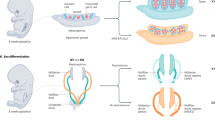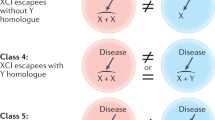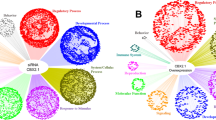Abstract
Sex determination is the series of molecular events that direct the undifferentiated bipotential gonad to become either a testis or an ovary. In humans, disruption of this process results in intersexuality, also referred to as disorders of sex development (DSD). Despite the discovery of the sex-determining gene SRY (sex-determining region Y) 15 years ago, the molecular mechanisms of sex determination remain poorly understood. Analysis of clinically relevant mutations of sex-determining genes in individuals with DSD has provided considerable insight into the function of these genes. The majority of disorders of sex determination with known causes are explained by mutations in one of three transcription factors at the core of the sex-determining pathway: SRY, SOX9 (SRY-box 9) and NR5A1 (nuclear receptor subfamily 5, group A, member 1). These mutations either affect the level of protein available at its nuclear site of action (via changes in regulatory sequences, deletions, non-sense mutations or mutations in nuclear localization sequences), or alter the structure of the protein (via modifications of binding or bending activity, or of interactions with other proteins). Deciphering the functional diversity of the mutations affecting the sex-determining pathway has immediate clinical impact on the diagnosis, outcome studies and classification of patients with DSD.
Key Points
-
The known molecular mechanisms of sex determination involve a growing network of genes, a large number of which are transcription factors
-
The transcription factors so far identified as having a major role in sex determination, namely SRY, SOX9 and NR5A1, can be disrupted by a number of mutations that can affect either their availability in the nucleus or their function
-
The types of mutations found in SRY, SOX9 and NR5A1 can be used as a guideline when screening additional transcription factors postulated to be part of the sex-determining cascade
-
Advances in our molecular understanding of intersexuality should be paralleled by a corresponding effort to improve the nomenclature used in diagnosing patients with disorders of sex development
This is a preview of subscription content, access via your institution
Access options
Subscribe to this journal
Receive 12 print issues and online access
$209.00 per year
only $17.42 per issue
Buy this article
- Purchase on Springer Link
- Instant access to full article PDF
Prices may be subject to local taxes which are calculated during checkout

Similar content being viewed by others
References
Wilhelm D et al. (2005) Sertoli cell differentiation is induced both cell-autonomously and through prostaglandin signaling during mammalian sex determination. Dev Biol 287: 111–124
Teixeira J et al. (2001) Müllerian inhibiting substance: an instructive developmental hormone with diagnostic and possible therapeutic applications. Endocr Rev 22: 657–674
Ross AJ et al. (2005) Signaling at the crossroads of gonad development. Trends Endocrinol Metab 16: 19–25
Yao HH (2005) The pathway to femaleness: current knowledge on embryonic development of the ovary. Mol Cell Endocrinol 230: 87–93
Brennan J and Capel B (2004) One tissue, two fates: molecular genetic events that underlie testis versus ovary development. Nat Rev Genet 5: 509–521
MacLaughlin DT and Donahoe PK (2004) Sex determination and differentiation. N Engl J Med 350: 367–378
Park SY and Jameson JL (2005) Minireview: transcriptional regulation of gonadal development and differentiation. Endocrinology 146: 1035–1042
Morrish BC and Sinclair AH (2002) Vertebrate sex determination: many means to an end. Reproduction 124: 447–457
Rey R et al. (2003) AMH/MIS: what we know already about the gene, the protein and its regulation. Mol Cell Endocrinol 211: 21–31
Parker KL et al. (2002) Steroidogenic factor 1: an essential mediator of endocrine development. Recent Prog Horm Res 57: 19–36
de Santa Barbara P et al. (2001) Steroidogenic factor-1 contributes to the cyclic-adenosine monophosphate down-regulation of human SRY gene expression. Biol Reprod 64: 775–783
Pilon N et al. (2003) Porcine SRY promoter is a target for steroidogenic factor 1. Biol Reprod 68: 1098–1106
Sekido R et al. (2004) SOX9 is up-regulated by the transient expression of SRY specifically in Sertoli cell precursors. Dev Biol 274: 271–279
Kidokoro T et al. (2005) Influence on spatiotemporal patterns of a male-specific Sox9 activation by ectopic Sry expression during early phases of testis differentiation in mice. Dev Biol 278: 511–525
McElreavy K et al. (1992) XY sex reversal associated with a deletion 5′ to the SRY “HMG box” in the testis-determining region. Proc Natl Acad Sci USA 89: 11016–11020
Assumpcao JG et al. (2005) A naturally occurring deletion in the SRY promoter region affecting the Sp1 binding site is associated with sex reversal. J Endocrinol Invest 28: 651–656
McElreavey K et al. (1996) Loss of sequences 3′ to the testis-determining gene, SRY, including the Y pseudoautosomal boundary associated with partial testicular determination. Proc Natl Acad Sci USA 93: 8590–8594
Foster JW et al. (1994) Campomelic dysplasia and autosomal sex reversal caused by mutations in an SRY-related gene. Nature 372: 525–530
Wagner T et al. (1994) Autosomal sex reversal and campomelic dysplasia are caused by mutations in and around the SRY-related gene SOX9. Cell 79: 1111–1120
Wirth J et al. (1996) Translocation breakpoints in three patients with campomelic dysplasia and autosomal sex reversal map more than 130 kb from SOX9. Hum Genet 97: 186–193
Velagaleti GV et al. (2005) Position effects due to chromosome breakpoints that map approximately 900 Kb upstream and approximately 1.3 Mb downstream of SOX9 in two patients with campomelic dysplasia. Am J Hum Genet 76: 652–662
Pop R et al. (2004) Screening of the 1 Mb SOX9 5′ control region by array CGH identifies a large deletion in a case of campomelic dysplasia with XY sex reversal. J Med Genet 41: e47
Levilliers J et al. (1989) Exchange of terminal portions of X- and Y-chromosomal short arms in human XY females. Proc Natl Acad Sci USA 86: 2296–2300
Page DC et al. (1990) Additional deletion in sex-determining region of human Y chromosome resolves paradox of X,t(Y;22) female. Nature 346: 279–281
Sinclair AH et al. (1990) A gene from the human sex-determining region encodes a protein with homology to a conserved DNA-binding motif. Nature 346: 240–244
Nakagome Y et al. (1991) PCR detection of distal Yp sequences in an XX true hermaphrodite. Am J Med Genet 41: 112–114
Olney PN et al. (1999) Campomelic syndrome and deletion of SOX9. Am J Med Genet 84: 20–24
Huang B et al. (1999) Autosomal XX sex reversal caused by duplication of SOX9. Am J Med Genet 87: 349–353
Hawkins JR et al. (1992) Mutational analysis of SRY: nonsense and missense mutations in XY sex reversal. Hum Genet 88: 471–474
Muller J et al. (1992) Analysis of the sex-determining region of the Y chromosome (SRY) in sex reversed patients: point-mutation in SRY causing sex-reversion in a 46,XY female. J Clin Endocrinol Metab 75: 331–333
Iida T et al. (1994) A novel nonsense mutation in the HMG box of the SRY gene in a patient with XY sex reversal. Hum Mol Genet 3: 1437–1438
Veitia R et al. (1997) Mutations and sequence variants in the testis-determining region of the Y chromosome in individuals with a 46,XY female phenotype. Hum Genet 99: 648–652
Brown S et al. (1998) A de novo mutation (Gln2Stop) at the 5′ end of the SRY gene leads to sex reversal with partial ovarian function. Am J Hum Genet 62: 189–192
McDowall S et al. (1999) Functional and structural studies of wild type SOX9 and mutations causing campomelic dysplasia. J Biol Chem 274: 24023–24030
Correa RV et al. (2004) A microdeletion in the ligand binding domain of human steroidogenic factor 1 causes XY sex reversal without adrenal insufficiency. J Clin Endocrinol Metab 89: 1767–1772
Hasegawa T et al. (2004) Testicular dysgenesis without adrenal insufficiency in a 46,XY patient with a heterozygous inactive mutation of steroidogenic factor-1. J Clin Endocrinol Metab 12: 5930–5935
Mallet D et al. (2004) Gonadal dysgenesis without adrenal insufficiency in a 46, XY patient heterozygous for the nonsense C16X mutation: a case of SF1 haploinsufficiency. J Clin Endocrinol Metab 89: 4829–4832
Tajima T et al. (1994) A novel mutation localized in the 3′ non-HMG box region of the SRY gene in 46,XY gonadal dysgenesis. Hum Mol Genet 3: 1187–1189
Shahid M et al. (2005) Three new novel point mutations localized within and downstream of high-mobility group-box region in SRY gene in three Indian females with Turner syndrome. J Clin Endocrinol Metab 90: 2429–2435
Sudbeck P and Scherer G (1997) Two independent nuclear localization signals are present in the DNA-binding high-mobility group domains of SRY and SOX9. J Biol Chem 272: 27848–27852
Li B et al. (2001) Human sex reversal due to impaired nuclear localization of SRY. A clinical correlation. J Biol Chem 276: 46480–46484
Harley VR et al. (2003) Defective importin β recognition and nuclear import of the sex-determining factor SRY are associated with XY sex-reversing mutations. Proc Natl Acad Sci USA 100: 7045–7050
Harley VR et al. (1996) The HMG box of SRY is a calmodulin binding domain. FEBS Lett 391: 24–28
Argentaro A et al. (2003) A SOX9 defect of calmodulin-dependent nuclear import in campomelic dysplasia/autosomal sex reversal. J Biol Chem 278: 33839–33847
Sim H et al. (2005) Defective calmodulin-mediated nuclear transport of the sex-determining region of the Y chromosome (SRY) in XY sex reversal. Mol Endocrinol 19: 1884–1892
Berta P et al. (1990) Genetic evidence equating SRY and the testis-determining factor. Nature 348: 448–450
Jager RJ et al. (1990) A human XY female with a frame shift mutation in the candidate testis-determining gene SRY. Nature 348: 452–454
Jager RJ et al. (1992) A familial mutation in the testis-determining gene SRY shared by both sexes. Hum Genet 90: 350–355
Vilain E et al. (1992) Familial case with sequence variant in the testis-determining region associated with two sex phenotypes. Am J Hum Genet 50: 1008–1011
Peters R et al. (1995) An SRY mutation causing human sex reversal resolves a general mechanism of structure-specific DNA recognition: application to the four-way DNA function. Biochemistry 34: 4569–4576
Kwok C et al. (1995) Mutations in SOX9, the gene responsible for Campomelic dysplasia and autosomal sex reversal. Am J Hum Genet 57: 1028–1036
Meyer J et al. (1997) Mutational analysis of the SOX9 gene in campomelic dysplasia and autosomal sex reversal: lack of genotype/phenotype correlations. Hum Mol Genet 6: 91–98
Thong MK et al. (2000) Acampomelic campomelic dysplasia with SOX9 mutation. Am J Med Genet 93: 421–425
Achermann JC et al. (1999) A mutation in the gene encoding steroidogenic factor-1 causes XY sex reversal and adrenal failure in humans. Nat Genet 22: 125–126
Achermann JC et al. (2002) Gonadal determination and adrenal development are regulated by the orphan nuclear receptor steroidogenic factor-1, in a dose-dependent manner. J Clin Endocrinol Metab 4: 1829–1833
Pontiggia A et al. (1994) Sex-reversing mutations affect the architecture of SRY-DNA complexes. EMBO J 13: 6115–6124
Rimini R et al. (1995) Interaction of normal and mutant SRY proteins with DNA. Philos Trans R Soc Lond B Biol Sci 350: 215–220
Mitchell CL and Harley VR (2002) Biochemical defects in eight SRY missense mutations causing XY gonadal dysgenesis. Mol Genet Metab 77: 217–225
Sock E et al. (2003) Loss of DNA-dependent dimerization of the transcription factor SOX9 as a cause for campomelic dysplasia. Hum Mol Genet 12: 1439–1447
Bernard P et al. (2003) Dimerization of SOX9 is required for chondrogenesis, but not for sex determination. Hum Mol Genet 12: 1755–1765
Tremblay JJ and Viger RS (2003) A mutated form of steroidogenic factor 1 (SF-1 G35E) that causes sex reversal in humans fails to synergize with transcription factor GATA-4. J Biol Chem 278: 42637–42642
Klebs E (1876) Handbuch der Pathologischen Anatomie (vol 1), 718. Berlin: Hirschwald
Dreger AD et al. (2005) Changing the nomenclature/taxonomy for intersex: a scientific and clinical rationale. J Pediatr Endocrinol Metab 18: 729–733
Author information
Authors and Affiliations
Corresponding author
Ethics declarations
Competing interests
The authors declare no competing financial interests.
Rights and permissions
About this article
Cite this article
Nikolova, G., Vilain, E. Mechanisms of Disease: transcription factors in sex determination—relevance to human disorders of sex development. Nat Rev Endocrinol 2, 231–238 (2006). https://doi.org/10.1038/ncpendmet0143
Received:
Accepted:
Issue Date:
DOI: https://doi.org/10.1038/ncpendmet0143
This article is cited by
-
TET2 catalyzes active DNA demethylation of the Sry promoter and enhances its expression
Scientific Reports (2019)
-
HDAC5-mediated deacetylation and nuclear localisation of SOX9 is critical for tamoxifen resistance in breast cancer
British Journal of Cancer (2019)
-
Neuroethics, Gender and the Response to Difference
Neuroethics (2012)



